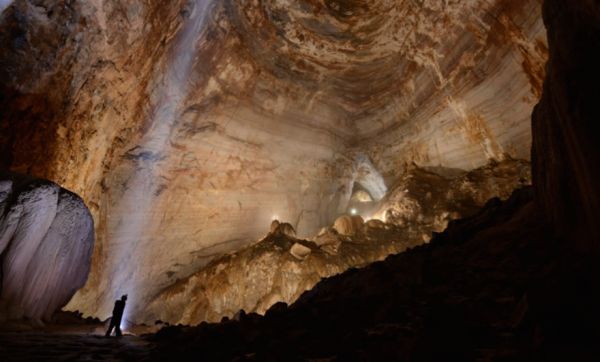Sauropods are best
known for being the largest dinosaurs ever to roam Earth. But a new
study of these ancient creatures focuses on a surprising fact: Some
sauropods were actually quite small.
The conclusion is based on the discovery of the fossil remains of the smaller-than-average sauropod dubbed Europasaurus holgeri
in 2006 in a quarry in northern Germany.The specimens were
approximately 20 feet (6 meters) long and are believed to have supported
dinosaurs weighing less than a ton each. While these dimensions may
seem large by today's standards — the animals were bigger than the
average horse — they belonged to animals that were significantly smaller
than other sauropods.
Scientists originally thought the fossils may have belonged to juvenile dinosaurs. But the new study determined that the fossils actually belonged to adult dwarf dinosaurs,
said lead researcher Martin Sander, a professor of vertebrate
paleontology at the Steinmann Institute of Geology, Mineralogy and
Paleontology at the University of Bonn in Germany.
The dwarfism exhibited in this rare discovery of sauropod fossils is a
result of what's known as island or insular dwarfism. This gradual
shrinking of a large species over several generations has also affected
other animals — like elephants and hippopotamuses — living in isolated
and cramped quarters.
This particular group of sauropods, Europasaurus holgeri, lived about 150 million years ago in what is now Europe. But during the Late Jurassic period, Europe was submerged in a shallow sea, and most of the animals that lived there inhabited small islands. Over time, Europasaurus evolved to better survive in its island habitat by shrinking, the researchers said.
To make their case, the researchers focused on the details of the
anatomy of these diminutive dinosaur specimens. They found that, in the
case of Europasaurus, two
different sizes of dwarf dinosaurs — a small dwarf and a large dwarf —
evolved during the Late Jurassic, Sander told Live Science in an email.
"Bone microstructure tells us that the largest of the two kinds of Europasaurus was fully grown," Sander said. "To find this out, we had to grind samples of Europasaurus bones into thin slices, about one-twentieth of a millimeter in thickness."
At this thickness, Sander explained, the bone becomes translucent and
can be studied with a microscope, allowing researchers to examine the
bones' microstructure. The researchers also examined the shapes of the
skull bones to determine each specimen's morphological ontogenetic stage
(MOS), or where that animal is over the course of its development.
Sander said both the MOS and the specimen's microstructure help researchers determine how old a dinosaur was when it died.
Once the researchers determined that the specimens they were studying did, indeed, belong to the dwarf dinosaur Europasaurus and not juvenile sauropods, one important question remained: How did Europasaurus get so small?
"To be a dwarf as a dinosaur, your ancestors have to have been giants," Sander said. "In the case of Europasaurus, this is not difficult to check because, with very few exceptions, all of those long-necked sauropods were giants. The question then becomes how to shrink your dinosaur."
Sander said there were two ways dinosaurs could shrink over the course
of evolution: Either a dinosaur could stop growing earlier than its
ancestor — after five years instead of 20, for instance — or a dinosaur
could grow for the same time period (say 20 years), but did so more
slowly, at half the speed.
In both cases, a dinosaur would end up being significantly smaller than its ancestor, Sander said. In the case of Europasaurus, both processes seem to have been at work. However, his team was not able to determine which process was dominant.
Another mystery left unresolved by the University of Bonn study is that of the origins of the two different "forms" of Europasaurus — what Sander refers to as "a small dwarf and a large dwarf." These two sizes of Europasaurus
could represent an instance of sexual dimorphism, Sander said, in which
males and females of the species are formed or sized differently.
However, scientists aren't ruling out another possibility: that the
fossils from the 2006 discovery represent two distinct Europasaurus species, separated either by time or by distance.

















